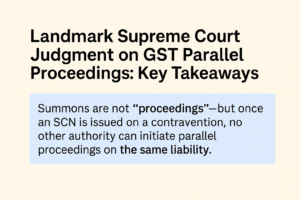Introduction
The Goods and Services Tax (GST) brought significant changes to the Indian taxation system, aimed at simplifying compliance and reducing the cascading effect of taxes. Among its provisions, the Composition Scheme and the Alternative Composition Scheme were introduced to benefit small taxpayers by providing a simplified tax structure. This blog delves into these schemes, exploring their purpose, eligibility, benefits, and compliance requirements, in an easy-to-understand manner.
Why Was This Scheme Needed?
Small businesses often find it challenging to comply with the complex GST requirements, including detailed record-keeping, multiple tax filings, and high tax rates. To alleviate this burden, the Composition Scheme was introduced, offering:
- Simplified compliance for small taxpayers.
- Reduced tax liability to enhance liquidity.
- Quarterly tax payments, easing cash flow management.
- Relief from the need to issue detailed tax invoices.
What is Composition Levy?
Under the Composition Scheme, eligible taxpayers pay a fixed, lower rate of tax on their turnover instead of the regular GST rates. This scheme aims to minimize the compliance burden while ensuring their contribution to the GST system. Businesses availing this scheme cannot claim input tax credit (ITC).
Eligibility Conditions for Opting into the Composition Scheme
Businesses must meet the following conditions to opt for the Composition Scheme:
- Turnover Limit:
- Aggregate annual turnover must not exceed ₹1.5 crore for most states.
- For special category states, the limit is ₹75 lakh.
- Nature of Business:
- Manufacturers, traders, and restaurant services (not serving alcohol) are eligible.
- Supply of any other service, if the value of the total service doesn’t exceed 10% of the previous Financial Year or ₹ 5 lakh, whichever is higher.
- Service providers can opt under the Alternative Composition Scheme with a turnover limit of ₹50 lakh.
Who is Not Eligible for the Composition Scheme?
The following categories are excluded from availing the scheme:
- Manufacturers of ice cream, pan masala, or tobacco.
- Businesses making interstate supplies.
- Casual taxable persons and non-resident taxable persons.
- Suppliers of non-taxable goods (e.g., alcohol).
- Businesses supplying goods via e-commerce operators.
- Taxpayers exceeding the prescribed turnover limit.
What is the Alternative Composition Scheme?
Why Was It Needed?
The Alternative Composition Scheme was introduced to address the needs of service providers and mixed suppliers who were previously excluded from the standard Composition Scheme. It provides similar benefits, such as simplified compliance and reduced tax rates, to this segment of taxpayers.
Eligibility Conditions:
- Turnover must not exceed ₹50 lakh in a financial year.
- Only service providers and suppliers of both goods and services are eligible.
Non-Eligibility:
- Manufacturers of ice cream, pan masala, or tobacco.
- Suppliers making interstate supplies.
- Casual taxable persons and non-resident taxable persons.
- Suppliers of non-taxable goods.
Conditions and Restrictions of Both Schemes
Common Restrictions:
- Cannot claim input tax credit.
- Must issue a Bill of Supply instead of a tax invoice.
- Cannot collect GST from customers.
- Must restrict activities to intra-state supplies only.
Specific Conditions for the Alternative Composition Scheme:
- Limited to service providers and mixed suppliers.
- Turnover computation includes all supplies made across the PAN.
Various Tax Rates Under the Schemes
| Type of Business | CGST | SGST | Total |
| Manufacturers and Traders (Goods) | 0.5% | 0.5% | 1% |
| Restaurants (not serving alcohol) | 2.5% | 2.5% | 5% |
| Service Providers under Alternative Scheme | 3% | 3% | 6% |
| Manufacturers of bricks | 3% | 3% | 6% |
Compliance Under the Scheme
- Tax Payment: Quarterly payment through Form CMP-08.
- Annual Return: Filing of Form GSTR-4.
- Record-Keeping: Simplified records compared to regular taxpayers.
Invoice Format for Composition Dealers
- Title: Bill of Supply
- Details:
- Name, address, and GSTIN of the supplier.
- Invoice number and date.
- Description of goods/services.
- Value of the supply.
- Supplier’s signature.
Other Useful Information and Do’s & Don’ts
Do’s:
- Regularly check turnover limits to remain eligible.
- File returns and pay taxes on time.
- Clearly state “Composition Taxable Person” on the Bill of Supply.
Don’ts:
- Do not claim input tax credit.
- Avoid making interstate supplies.
- Do not supply goods/services through e-commerce operators.
Conclusion
The Composition Scheme and Alternative Composition Scheme under GST provide much-needed relief to small businesses and service providers, simplifying compliance and reducing tax burdens. By understanding the eligibility, conditions, and compliance requirements, businesses can make informed decisions about opting for these schemes to streamline their operations and focus on growth.



Add comment